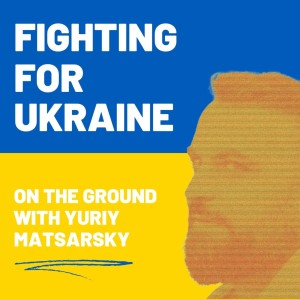
September 10th 2023
Yuriy candidly reveals his fears and uncertainties about providing life-saving first aid to comrades on the front lines, highlighting the immense challenges of administering aid under fire and the vital role played by regular soldiers in such life-and-death situations.
You can email Yuriy, ask him questions or simply send him a message of support: fightingtherussianbeast@gmail.com
You can help Yuriy and his family by donating to his GoFundMe: https://www.gofundme.com/f/help-yuriys-family
Yuriy’s Podbean Patron sign-up to give once or regularly: https://patron.podbean.com/yuriy
Buy Yuriy a coffee here: https://bmc.link/yuriymat
TRANSCRIPT: (Podbean app users can enjoy closed captions)
It is 10th of September.
In this war, there is one thing I fear even more than being captured: the fear that I won't be able to save one of my comrades if they get injured and I'm the only one nearby. Yes, I've undergone training in basic first aid; I've applied tourniquets to stop bleeding and learned how to evacuate the wounded properly. But all of that was in a relatively peaceful conditions, not under fire and certainly not in the heat of the battle. Moreover, it was under the watchful eye of an instructor who corrected my mistakes.
In calm surroundings, I can easily stop bleeding and carry a person several miles to safety. But the challenge lies in doing all of this in the most tumultuous of situations, amid gunfire with adrenaline coursing through my veins, when every fiber of my being trembles from the rush. In these moments, you begin to understand why not everyone can be a combat medic. To administer first aid under fire, you must be a person who can master their own emotions, someone who can quell their fear, override their adrenaline surges, and do their job regardless of the chaos around them.
Yet, there is not always a medic nearby who can shoulder the responsibility of saving a wounded fighter life. Often, it falls upon regular soldiers, the injured person's comrades, and in the midst of the battle, it is exceedingly difficult for someone unaccustomed to this task to provide qualified assistance. Let me briefly explain how the system of saving lives on the frontline works. You see, each soldier has what we call tourniquets, devices used to stop bleeding from limbs. It's a modern tourniquet with a built in lever for better tightening.
The tourniquets are affixed to the uniform or body armor so that others can easily find them. The wounded person is aided using their own tourniquet. It's crucial that this tourniquet is applied above the wound correctly, with the lever properly tightened. Furthermore, it is important to mark the time of its application with a pen on the tourniquet. This is very, very important. About every half an hour you should loosen the tourniquet slightly, allowing blood to flow back into the limb. If you fail to do this or do it at the wrong time, the limb could be lost. And if you don't tighten the tourniquet enough, the person will bleed out and die. It gets even more complex when the injury isn't in the limb, but in the torso. In most cases, to save someone with a torso injury, you need to remove their body armor, which often makes it impossible to access the wound. Then, on the often bloodied body, You must locate the wound and apply a special hemostatic dressing to it.
And it's absolutely crucial to evacuate the wounded as quickly as possible without removing the tourniquet or dressing. Considering that all of this must be done under enemy fire, risking one's life. It's an extremely challenging job, and I am not certain that if the need arises for me to save a comrade's life, I'll handle it as needed. And this uncertainty is a very terrifying and unsettling thing.
Comments (0)
To leave or reply to comments, please download free Podbean or
No Comments
To leave or reply to comments,
please download free Podbean App.